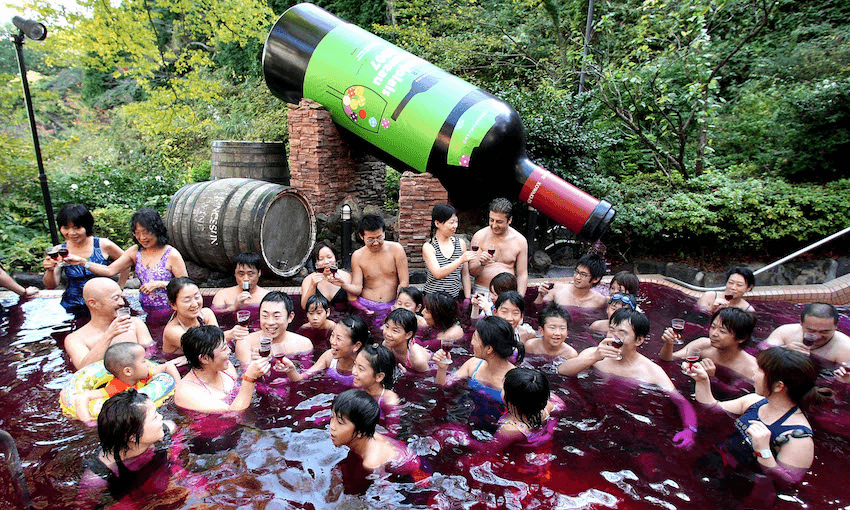This Thursday is Beaujolais Nouveau Day, and you don’t have to buy into a quaint-French-custom-turned-grotesque-celebration-of-capitalism — or drink something that tastes like raspberry vinegar — to get involved.
A dilemma presents itself to me every year as the third Thursday of November approaches.
I’m not one to deliberately forego an excuse to drink wine, but this dreaded day — this year falling on the 15th of November — is the day that Beaujolais Nouveau is released upon the poor, unsuspecting world.
Should I partake in an overpriced glass of raspberry vinegar that has no business being wine just yet? Should I indulge the corporate overlords that took a quaint French custom and turned it into a grotesque celebration of capitalism? Or should I stick to my beloved happy hour Hallertau at Conch?
Beaujolais Nouveau is a worldwide industry with its roots in the post-harvest celebrations of vineyard workers. It’s big in the US, where it both pairs and coincides nicely with Thanksgiving turkey, and in Japan, where you can literally bathe in a hot pool filled with Beaujolais.
It is less so in New Zealand, where we make so much of our own wine that often the wine world’s goings-on miss us entirely. That’s not to say that there’s no Beaujolais in New Zealand — it’s just a bit less likely to be of the bland and boring Nouveau variety.
There are a few different tiers of Beaujolais wines. The simple table wines aren’t seen much outside of France, while the Villages wines, made from a smaller geographic area and to slightly more stringent quality standards, can be found on bottom shelves and back corners in neighbourhood wine stores in New Zealand.
Beaujolais cru wines, however, have started to become a fixture on adventurous and interesting wine lists around the country, jostling for space with the skin-contact rieslings and the grower champagnes. These are the most prestigious of the area’s wines, and are currently very popular with the vinously inclined because they are light and earthy, full of minerality and great with food. There’s also something to say for their point of difference in New Zealand’s pinot noir-dominated wine market.
There are 10 villages in the north of Beaujolais that create the Beaujolais cru wines. Here, the granite soils and rolling hills provide a terroir that is suited to the gamay grape variety alone. The grape was banished here in the 14th century from Burgundy, so the Burgundians could focus on making outrageously expensive wines from pinot noir. This turned out to be a fortuitous development, however, as gamay works very well here, making some extremely delicious and relatively inexpensive wines.
Under French law, wines made in one of the 10 Beaujolais cru villages can have the name of the village on the bottle. Some of these villages, like Morgon, Fleurie and Moulin-a-Vent, have become reasonably well-known, while others, like Régnié and Chiroubles, are a little more B-list. This isn’t to say they’re not as good — it’s just that French wines that are easy to pronounce in English tend to find fame a little more easily. We have accepted champagne into our lives a lot more readily than say, viognier.
There is plenty of variation across the crus. Wines from Morgon and Moulin-à-Vent are more robust and full-bodied (relatively speaking —Barossa shiraz they are not), and are better for the nights when you wonder if you were too hasty in putting away the winter duvet.
Crus like Fleurie and Chiroubles are on the lighter end of the spectrum, although no less complex. These wines are something to sip on a late Saturday afternoon in November while the sun still reaches into the backyard, maybe after they’ve hung out in the fridge for half an hour.
Beaujolais cru wines are the perfect transition between brooding wintertime cabernets and fresh, summery rosés. Because of the connection between Beaujolais and the harvest in their homeland of France, these are often thought of as autumnal wines, but they work really well for us here in the southern hemisphere as well.
In fact, a bottle of Beaujolais cru wine pairs perfectly with the New Zealand springtime: sausages that have a winter’s worth of flavour build-up from the barbecue, the smell of musty deckchairs just unearthed from their hibernation, and being shielded from the crisp bite of twilight by the weave of your favourite sweatshirt.
So Beaujolais cru wines are the perfect thinking woman’s tipple for Beaujolais Nouveau day. They are close enough in spirit to Nouveau that you feel like you are still celebrating, but nice enough that you don’t have to choke your glass down, the words “Le Beaujolais Nouveau est… horriblé” tumbling from your wine-stained lips.

